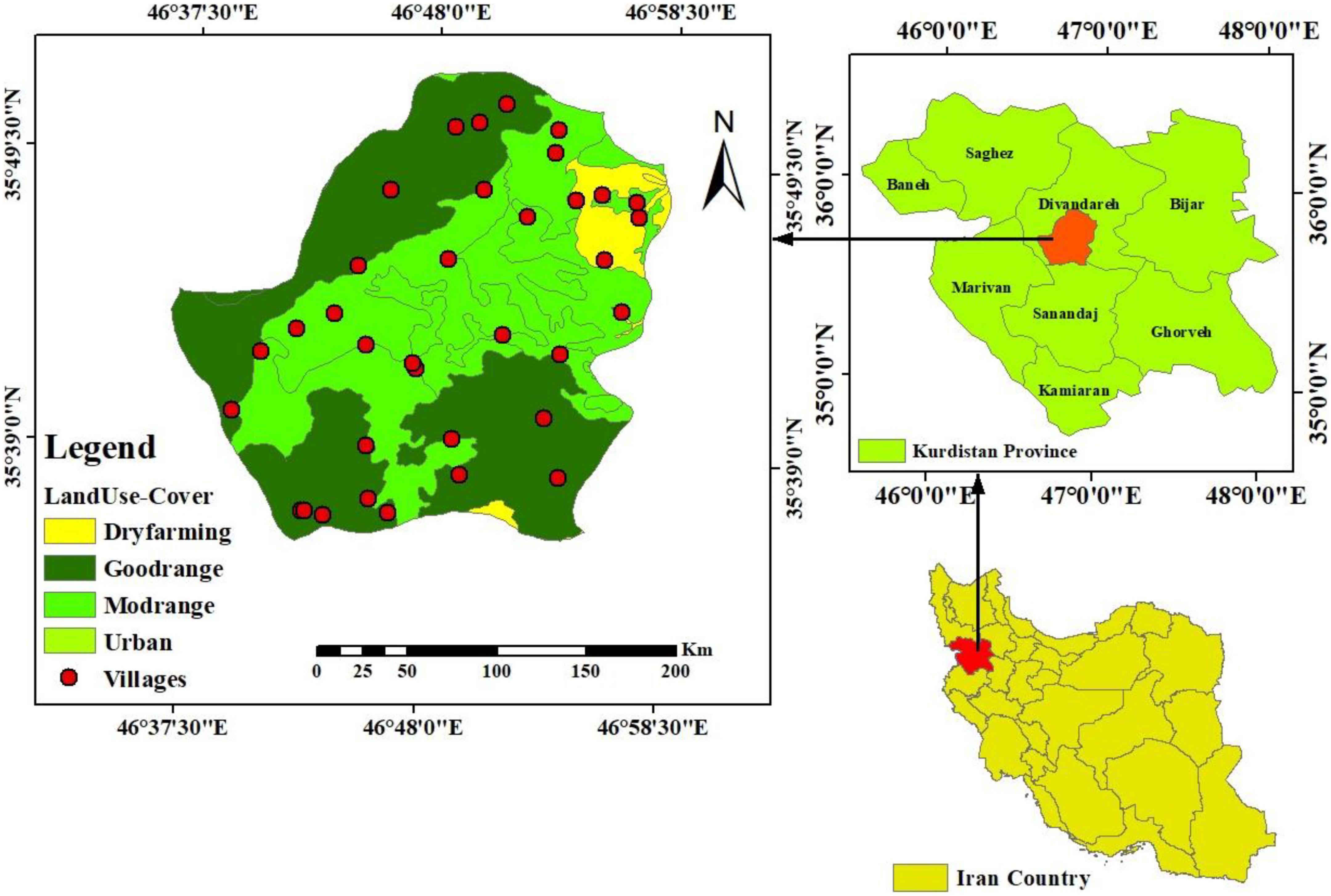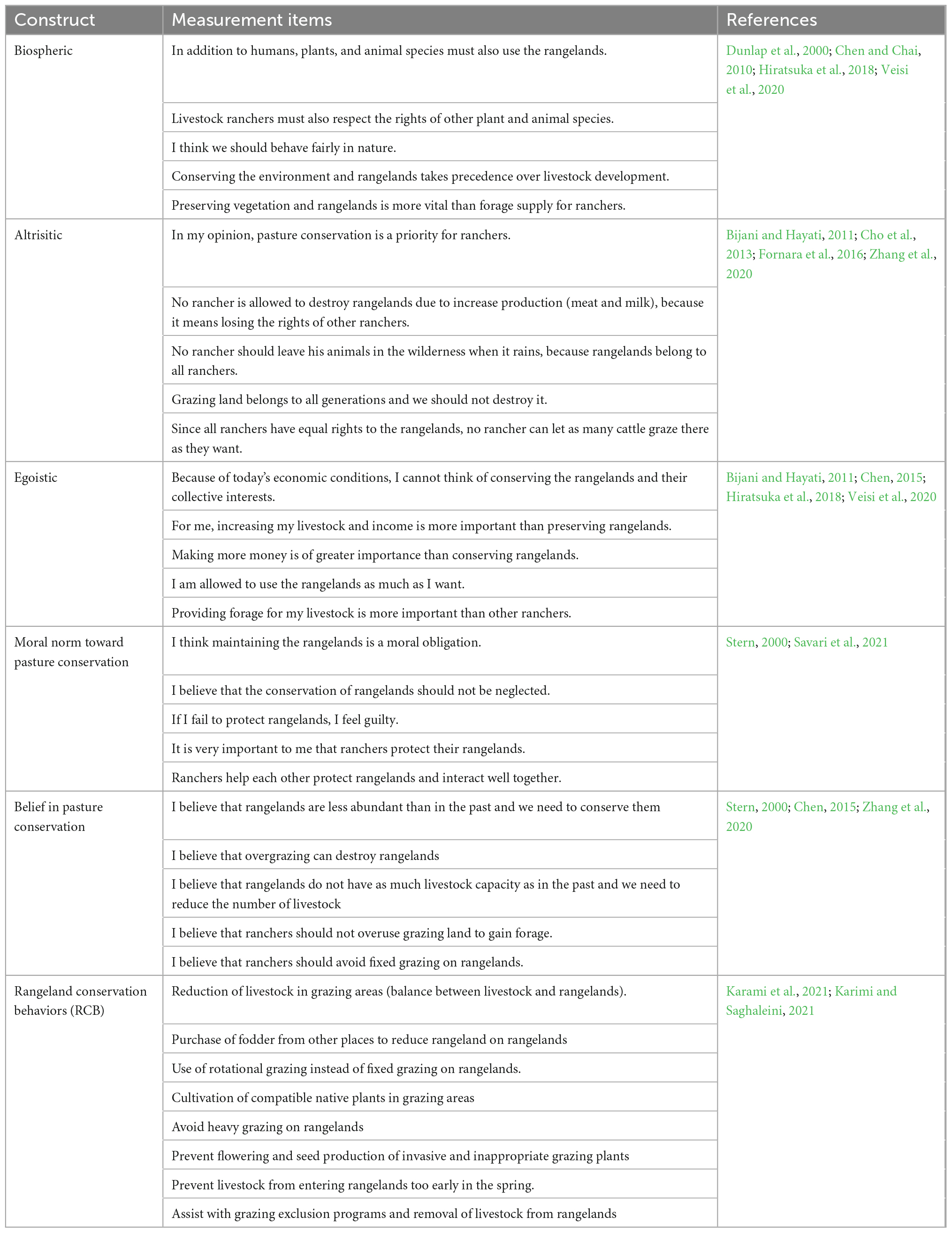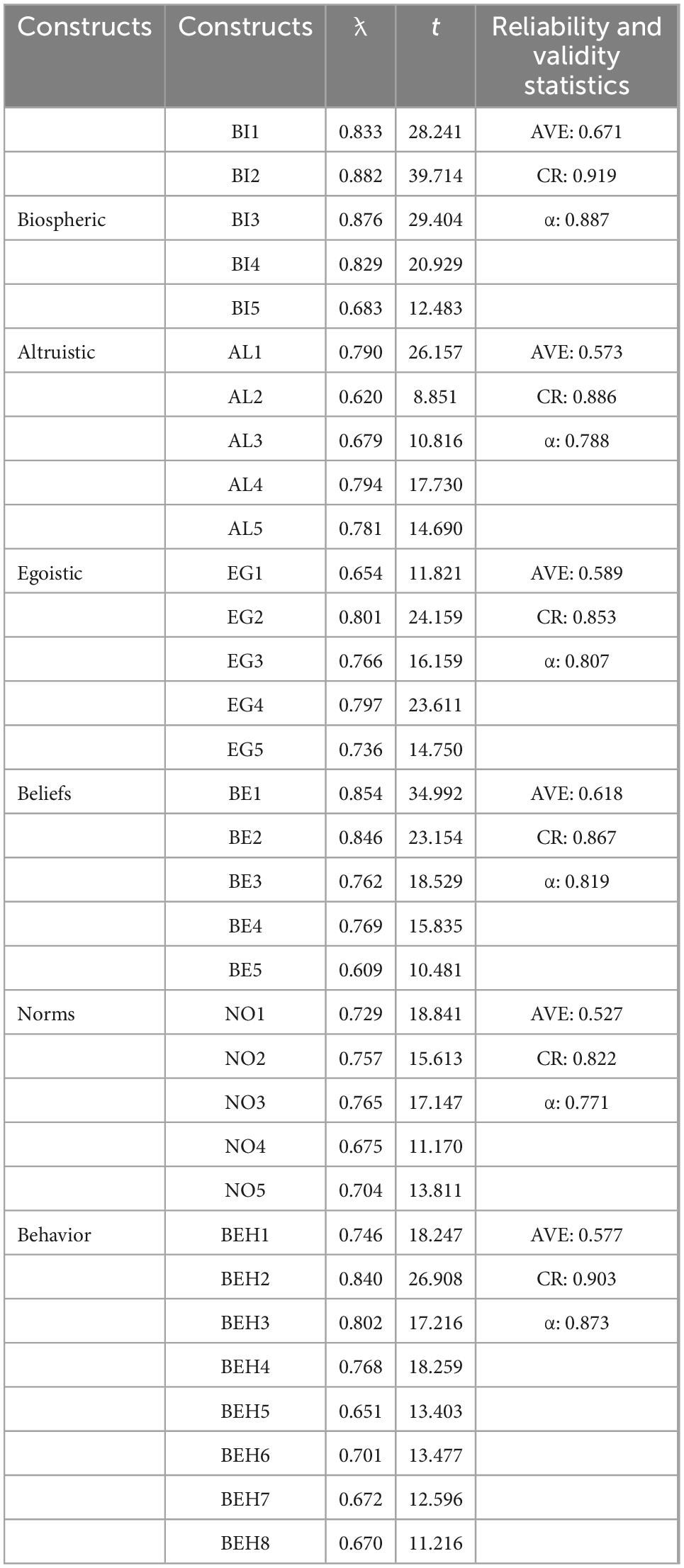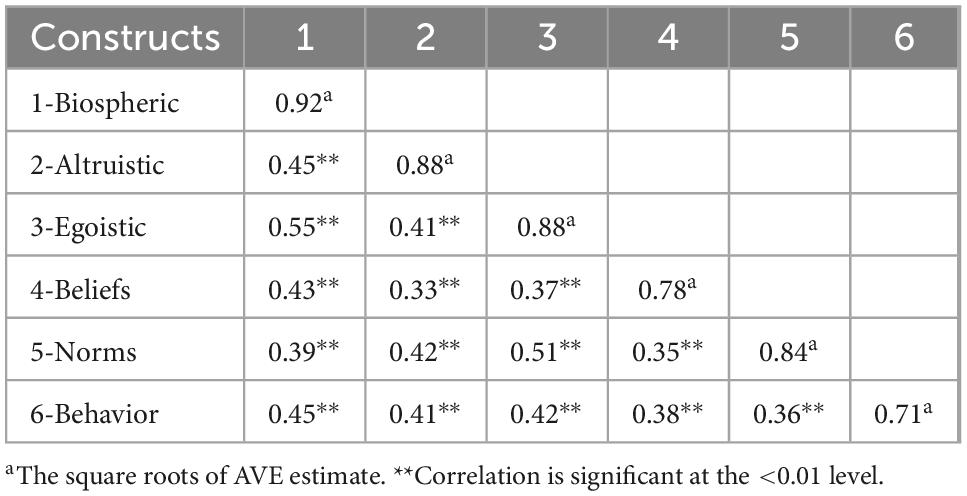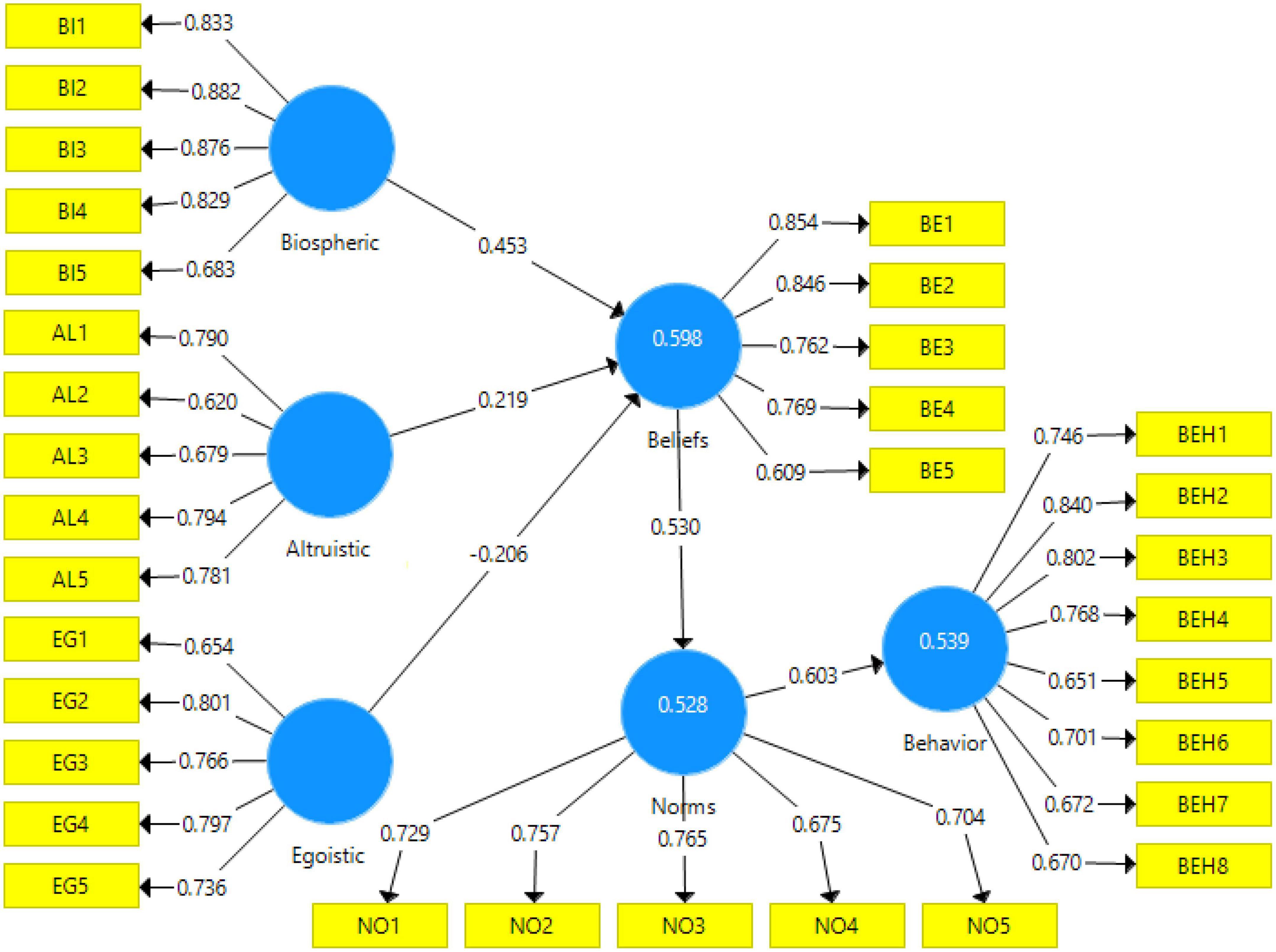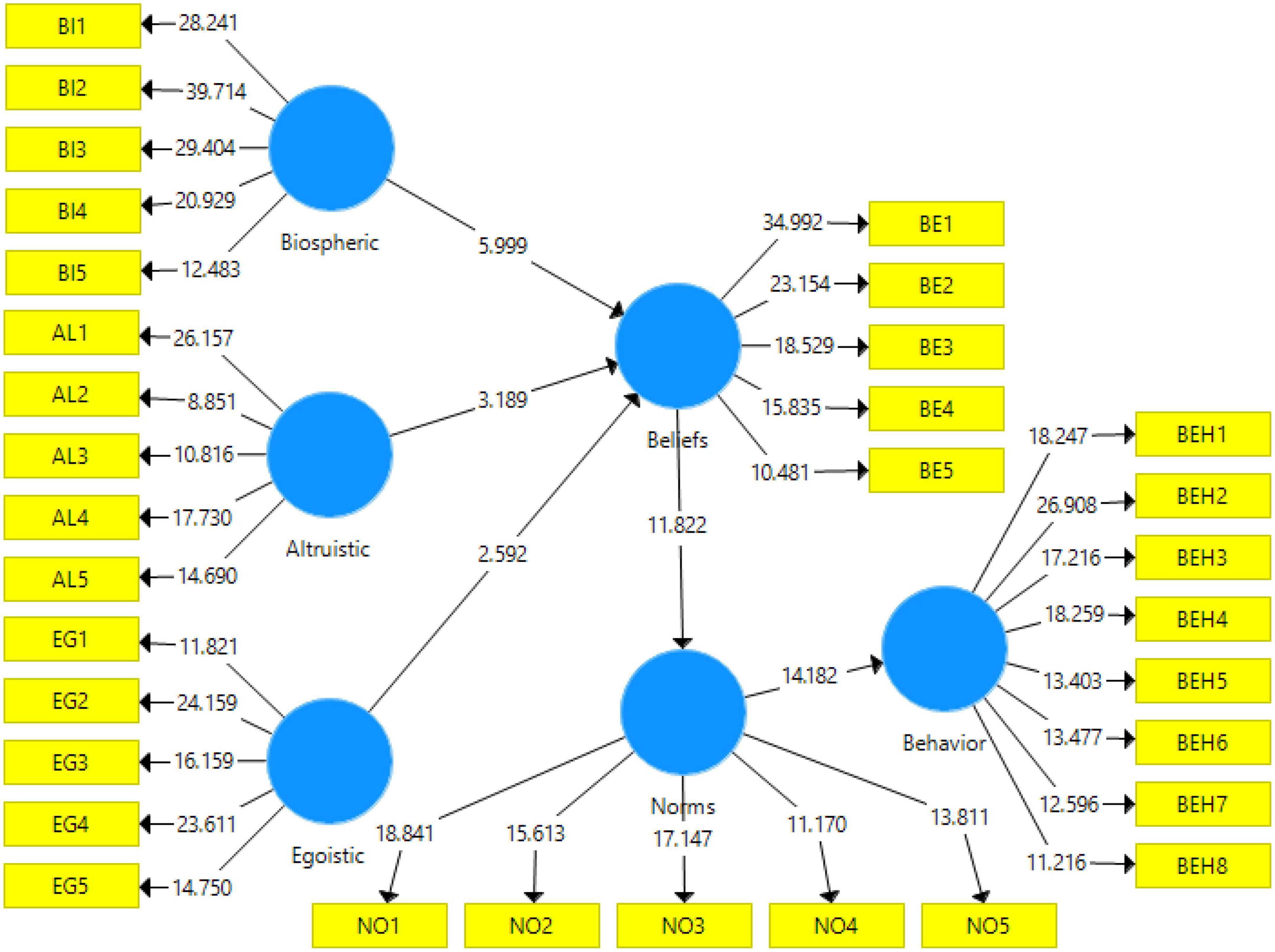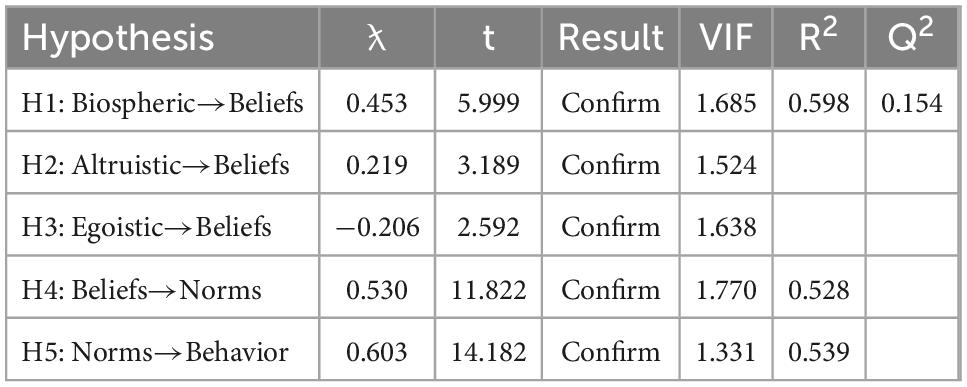- Department of Agricultural Extension and Education, Agricultural Sciences and Natural Resources University of Khuzestan, Mollasani, Iran
Rangeland are one of the most important natural habitats for the protection of living and non-living organisms. Degradation of rangeland is one of the biggest threats to biodiversity loss. Ranchers’, as the most important key stakeholders who have a direct relationship with rangelands, have put a lot of pressure on the rangeland sector in recent years, so that this natural habitat has been destroyed. Therefore, existing rangelands must be preserved to protect biodiversity. One of the most important strategies to protect rangeland is to change the behavior of ranchers to friendly and ecological behaviors in the environment. In this regard, this study was conducted with the general aim of explaining the ranchers’ behavior of rangeland conservation in western Iran. The main research tool was a questionnaire whose validity was confirmed by a panel of experts and its reliability was confirmed by Cronbach’s alpha coefficient. In this study, value-belief-norm (VBN) was used to identify research variables. The results showed that ranchers have used different behaviors to protect rangelands and egoistic behaviors are the main cause of the destruction of this natural habitat. In addition, the results of this study showed that the framework used was an efficient theory because it explains 53.9% of rangeland conservation behavior. Finally, in this study, based on the research findings, applied policies for the protection of natural rangelands were presented so that in addition to rangeland conservation, biodiversity can also be preserved.
Introduction
Nearly half of human societies depend on the products and services of the rangeland, the largest ecosystem on Earth (Eddy et al., 2017; Brunson et al., 2021). It is estimated that 30–50% of the world’s land surface is covered by rangelands (Sugita et al., 2007; Dinan et al., 2021). In Iran, there are about 84.7 million hectares of grazingland, which accounts for 52% of the country’s total land surface. The total grazing area in Iran consisted of 8.5, 25.3, and 66.2% of dense, semi-dense, and low-density pasture, respectively (Asaadi and Yazdi, 2011; Karimi and Saghaleini, 2021). Rangeland is considered one of the most important sources of production in this country and plays a key role in supplying forage for domestic animals and food production (Karimi and Saghaleini, 2021; Savari and Zhoolideh, 2021; Savari and Moradi, 2022). Grazing land is therefore one of the most important natural resources of a country, providing the basis for other activities such as agriculture and animal husbandry. Hence, taking measurements to conserve these natural resources is of high importance (Noguera-Mendez et al., 2016). Rangeland ecosystems provide several key services, including medicinal plant production, forage provision, climate regulation, soil and water conservation, and environmental conservation (Prager et al., 2015). In recent decades, many efforts have been made to protect rangelands. For instance, the Returning Grazing Land to Grassland project was launched in 2003 (Wang et al., 2013). Nevertheless, these efforts have not been effective as the degradation of rangelands is increasing (State Forestry Administration [SFA], 2005, 2011, 2015). In the last three decades, Iranian rangelands have been destroyed to a greater extent than those of European and American countries, so that more than 20% have been destroyed quantitatively and qualitatively (Food and Agriculture Organization [FAO], 2013). There are 124 million livestock units in Iran, 83 million of which depend on Iranian rangelands. However, Iranian rangelands are only capable of feeding about 37 million livestock units within 7 months or about 24.6 million livestock units within a year. Consequently, Iranian rangelands are currently being used 2.2 times more than their allowable capacity (Karami et al., 2021). As a result, the imbalance between the livestock population and the tolerance capacity of Iranian rangelands has destroyed many grazing areas and subsequently eroded the soils (Savari et al., 2022a,b). Therefore, illegal grazing is the main cause of rangeland degradation (Noguera-Mendez et al., 2016; Wassie, 2020; Besada, 2021) because livestock grazing affects various components of rangeland ecosystems such as soil, water, floral composition, diversity, and forage quality on the performance of the whole ecosystem (Hein, 2006; Retzer, 2006; Eldridge et al., 2016; Lu et al., 2017; Karami et al., 2021). Intermittent grazing, on the other hand, is associated with a positive effect on plant traits and rangeland ecosystems. Seasonal grazing restricts the selection of grazing livestock, which reduces the production of invasive seeds and increases flowering traits such as plant growth and survival (Earl and Jones, 1996; Zhang et al., 2017). However, more than 70% of rangeland degradation is attributed to human activities, to improve rangeland conservation, ranchers in particular need to improve their environmental behavior (Food and Agriculture Organization [FAO], 2013; Lepak et al., 2021). According to this evidence, ranchers are more involved in the rangeland ecosystem than any other part of society and play a key role in its degradation and conservation (Folke, 2006; Kovács et al., 2021). Currently, pastoralist behavior in rangeland conservation is not well-studied (Lu et al., 2017; Ohta et al., 2020; Karami et al., 2021; Karimi and Saghaleini, 2021). What has been emphasized more in past studies has been the control of livestock farmers’ behavior through incentives and restrictions (Katuwal, 2012; Kovács et al., 2021) and policy makers have planned without considering the viewpoints and attitudes of farmers. Meanwhile, examining people’s views and norms precedes any activity in the field of environmental protection (Savari et al., 2022b).
The use of social-psychological models and theories is one of the most important methods for studying conservation behavior and its preventive factors (Turaga et al., 2010; Yazdanpanah et al., 2015; Savari and Gharechaee, 2020; Karimi and Saghaleini, 2021; Savari et al., 2022c). Environmental psychological studies are important because they show that sustainable behavior in the environment requires individuals to internalize norms and behaviors, as incentives and constraints cannot produce sustainable manners in them (Savari et al., 2022d). According to psychological theories, the pro-environmentally behavior of people is influenced by psychological factors such as attitudes, beliefs, feelings, norms, and values (Bagheri et al., 2019; Rezaei et al., 2019; Savari and Gharechaee, 2020). However, sociologists and psychologists have proposed various theories to study the environmental behavior of users, the most important of which are the following norm activation model (NAM) (Schwartz, 1977), theory of planned behavior (TPB) (Ajzen, 1991), and value-belief-norm (VBN) (Stern, 2000). Among these views, VBN received attraction due to its comprehensiveness, simplicity of variable measurement, emphasis on psychological aspects, especially internal values and beliefs, and relevance of variables to environmental factors (Chen, 2015; Lind et al., 2015; Veisi et al., 2020). Interestingly, only this theory considers the worldview of human ecology in nature (Chen, 2015). Thus, this study aimed to identify the factors that influence ranchers’ behavior of rangeland conservation in western Iran. Two main objectives were pursued: (i) to use VBN ability in identifying the factors influencing rangeland protection behaviors, and (ii) to develop practical interventions to strengthen rangeland protection behaviors in Iran.
Theoretical framework
Value-belief-norm (VBN)
There are several approaches to explain human behavior in the use of natural resources such as water, forests, and rangelands. These methods are called logical and moral strategies with different assumptions (Steg and Vlek, 2009). Stern et al. (1999) combined values theory, including the New Ecological Paradigm (NEP) and NAM, and developed VBN theory to describe environmental behaviors. As a theory, VBN examines normative factors that contribute to sustainable attitudes and behaviors (Fornara et al., 2016). VBN theory provides a causal chain of explanations for environmental behavior (Chou, 2014; Huffman et al., 2014; Stevenson et al., 2014) that moves from stabilized and permanent elements of personality and belief to a greater focus on the unfortunate consequences of one’s values and personal responsibility to reduce risk (Chen, 2015; Lind et al., 2015).
As an moral approach, NEP emphasizes moderation and balance in the exploitation of nature because of the limitations it places on man’s use of natural resources. In other words, its strategy considers humans as part of nature, in contrast to the prevailing paradigm, which is a rational approach (Dunlap et al., 2000). According to VBN theory, this view introduces different values for natural resources such as forests, rangelands, and water that determine the underlying attitude and behavioral framework of individuals toward the environment (Ibtissem, 2010). VBN assumes that personal moral norms are activated by individuals who become aware of the adverse impacts of certain environmental conditions that threaten their desired values. As a result, individuals take responsibility for these devastating consequences (Stern, 2000; Zhang et al., 2020).
The theory considers the variables of environmental values attitudes (altruistic, biospheric, and egoistic), beliefs, norms, and behaviors that have specific relationships (Stern, 2000; Bijani and Hayati, 2013). According to VBN theory, behavioral beliefs are based on biospheric, altruistic, and egoistic values (Stern, 2000; Chen, 2015). Altruistic and biospheric orientations positively influence behavioral beliefs, whereas egoistic orientations negatively influence them (Hiratsuka et al., 2018; Zhang et al., 2020). Egoistic people tend to evaluate environmental aspects based on how the environment affects them. In other words: If they understand that there is a cost to using protective behaviors in the environment, they should avoid them (Chen, 2015). Those who are altruistic, on the other hand, typically evaluate aspects of the natural environment based on benefits and costs to human groups (Cho et al., 2013). Biospheric people evaluate the environment based on the benefits and costs it has to the ecosystem. People who value natural resources and the environment are more likely to prevent threatening situations to the ecosystem (Chen and Chai, 2010). In other words, people’s values influence their perceptions of the consequences of ecosystem change for themselves, for other people, and other species within the ecosystem (Stern and Dietz, 1994). The term environmental beliefs refer to a system of attitudes that determine an individual’s norms toward the environment and are the guiding principles in interacting with the environment (Corral-Verdugo et al., 2003). People’s beliefs and attitudes are the first things that affect the environment and determine their behavior toward it, as they specify how the different components of the ecosystem are valued (Wensing et al., 2019; Ranjbar and Naeimi, 2020). Consequently, understanding people’s environmental beliefs and identifying the factors that influence them is critical to environmental behavior research (Budak et al., 2005). According to VBN theory, personal norms are a key factor that directly influences environmental behavior (Stern, 2000; Phipps et al., 2013; Chou, 2014). In fact, moral norms are an internal emotional concept that ethically compels one to take actions that are consistent with one’s values (Karimi and Saghaleini, 2021). Moral norms refer to one’s sense of moral commitment to do or refrain from doing certain things that lead to environmentally friendly behavior (Yuan et al., 2021). Finally, pro-environmental behavior in this theory refers to conscious actions of individuals toward the environment, which include a wide range of feelings, desires, and willingness to perform desired actions. These behaviors aim to minimize the negative impact of human activities on the environment and improve it (Savari et al., 2021). Therefore, research hypotheses were raised based on Figure 1:
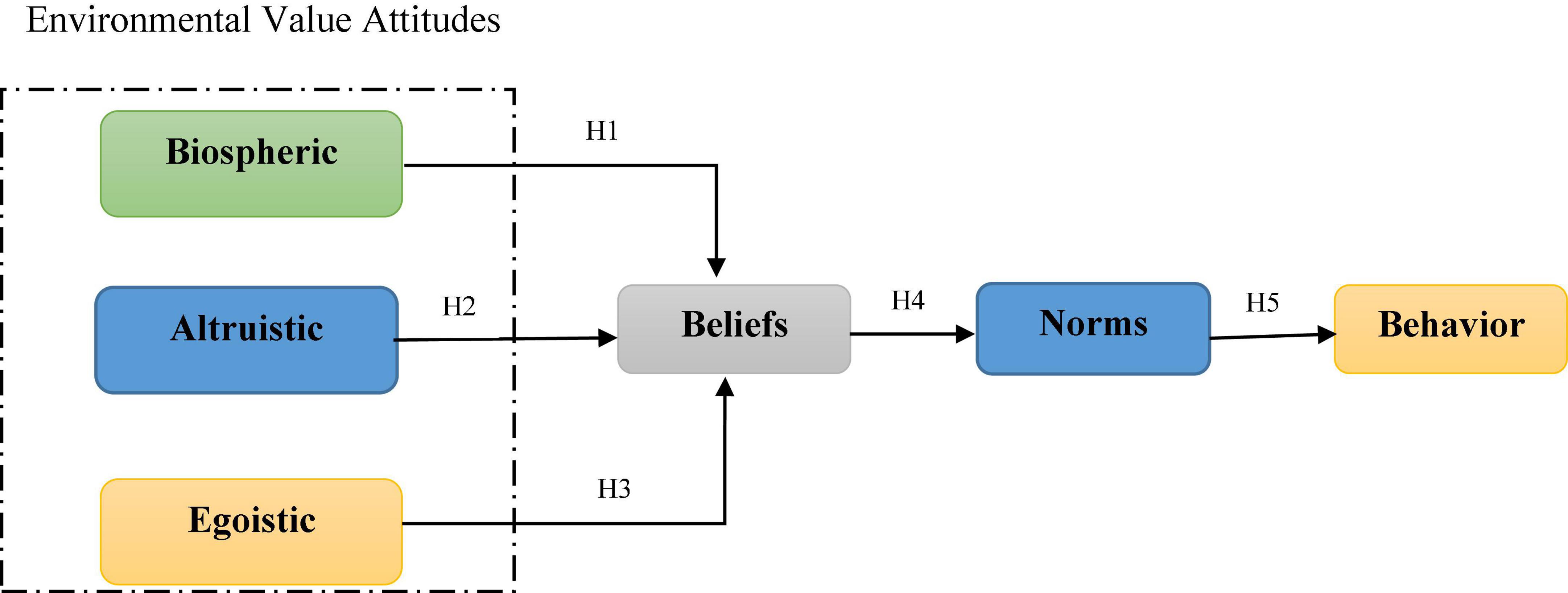
Figure 1. Causal chain of variables in VBN theory (Stern, 2000).
H1. Environmental value attitudes (Biospheric) has a positive and significant effect on beliefs.
H2. Environmental value attitudes (Altruistic) has a positive and significant effect on beliefs.
H3. Environmental value attitudes (Egoistic) has a negative and significant effect on beliefs.
H4: Beliefs has a positive and significant effect on norms.
H5. Norms has a positive and significant effect on rangeland protection behavior.
Materials and methods
Statistical population and sampling method
The statistical population of the study included all ranchers in the Saral district of Kurdistan province (Western Iran). According to Krejcie and Morgan (1970), 385 pastoralists in 15 villages were selected for the study. The sampling was conducted as a multistage stratified method with proportional allocation. This means, we tried to select the samples with proper distribution at the regional level so that the selected samples have high capability and reliability.
Study area
This investigation was carried out in 2020 and 2021 in a mountainous area approximately 35 km from Sanandaj (46450–46490 E and 35320 N–35360 N latitude) at an altitude of 2145 m (Figure 2). Saral district with an area of 1000 km2 is located in Kurdistan province in western Iran. The average annual rainfall in this region is 480 mm (Iran Meteorological Organization, 2019). The climate in this area is cold and semi-arid. Saral has sandy loam soils which are excellent for grazing livestock (cattle, sheep, goats). Grazing (grazed sites) in this area by sheep, goats, cows and wild animals takes place from late April to late July without any additional management practices (Karami et al., 2021). Ecologically, Saral district is a safe habitat for diversity of plants and animals. Notably, this natural region has not been studied in an accurate and systematic way so far, and the majority of studies have focused on the plant and animal species in this region rather than the factors leading to degradation. The main occupation of the people in the Saral region is animal husbandry, as it is one of the most vulnerable areas for animal husbandry and is known as such throughout Iran (Figure 2).
Participants
According to the results, the average age of the participants was 52.44 ± 7.33 years. In addition, the results showed that the majority of the respondents 274 (71.16%) were male and 345 (89.61%) were married. In terms of education, results showed that among the respondents 73 were illiterate, 85 were primary school students, 82 were middle school students, 79 were graduate diplomas, and 66 received higher education. In addition, the average number of livestock was 27.22 sheep, 9.12 goats, and 1.24 cows. In addition, the livestock ranchers obtained more than 50% of the feed required by their domesticated animals from the rangelands and the animals grazed on the rangelands for more than 180 days.
Measurements
The main research tool was a questionnaire consisting of two general parts. The first part dealt with the personal and occupational characteristics of pastoralists. The second part consisted of 33 items measuring theoretical structures (VBNs) divided into six sections: (i) five items measuring biospheric value attitude, (ii) five items measuring altruistic value attitude, (iii) five items measuring evaluation of egoistic value attitude, (iv) five items measuring moral norms, (v) five items measuring behavioral beliefs, and (vi) eight items measuring rangeland conservation behaviors (RCB). Then, participants were asked to express their agreement or disagreement on the Likert scale (1-very low to 5-very high) to reduce statistical errors (Fornell, 1992). One of the most important points of this research was to measure the theoretical variables (VBN) using previous studies. The items of the questionnaire are shown in Table 1.
Validity and reliability of instrument
An expert panel reviewed the survey draft and questions before interviewing farmers to assess the general indicators measured. The panel included professors from the fields of agricultural extension and education, environment, psychology, social sciences, and agricultural sciences, and modifications were made based on their opinions until final approval. In addition, Cronbach’s alpha coefficients and combined reliability were calculated to test the reliability of the questionnaire, which showed acceptable values (Table 3).
Data analysis
Data were collected and analyzed using SPSS23 and Smart Pls software. Structural Equation Modeling (SEM) is widely used by researchers because it provides the opportunity to test theories in the form of equations between variables. Moreover, this method can take into account the measurement error so that researchers can analyze the data by specifying the measurement error (Khoshmaram et al., 2020). Conventional models in SEM consist of two parts (Hair et al., 2014). A measurement model that examines how hidden variables are explained by explicit variables (questions), and a structural model that shows how hidden variables are related to each other (Hair et al., 2017). Furthermore, in this study, the ISDM1 index was applied to classify rangelands conservation behaviors (Gangadharappa et al., 2007):
Results
Assessing the status of VBN model variables among respondents
As explained in the research method, the ISDM index was used to group the variables applied to the VBN model and rangelands protection behavior among ranchers’. According to the obtained results, the studied ranchers’ did not show any considerable rangelands protection behavior, and only 24.94% had high protection behaviors, while the majority (48.57%) exhibited moderate rangelands protection behaviors. Moreover, two variables of VBN model, including moral norm and belief were at higher rank rather than other variables (Table 2).
Measurement model evaluation
This step determines whether the structures were measured accurately. To answer this question, the three phases of unidimensionality, reliability and validity, and discriminant validity were examined.
Unidimensionality
This step was assessed by factor loading and t-values. According to the values presented (Table 3), it can be claimed that the factor loading values presented for selected markers were statistically significant (above 0.6) and at the one percent error level (P < 0.01). The results confirmed the unidimensionality of the selected markers. Therefore, it can be concluded that the markers were selected correctly for the evaluation of research structures that measure exactly the same component.
Reliability and validity
In this step, the Combined Reliability (CR), Cronbach’s alpha, and Average Variance Extracted (AVE) were examined. The results presented in Table 3 indicated that the CR of all the structures in the proposed research model was more than 0.60 and their Cronbach’s alpha coefficients were more than 0.70. Moreover, the AVE for all structures of the proposed research model was above 0.50. Therefore, all latent variables had high reliability and validity, meaning that the items measuring the research structures were carefully selected and allowed the experiment to be repeated.
Discriminant validity
Diagnostic validity exists when questions measuring one variable are distinct or distinguishable from questions measuring other variables. Based on statistics, the research variables are of adequate diagnostic validity if the root mean of the calculated AVE variance between them is greater than the correlation between them (Fornell and Larcker, 1981). According to the results presented in Table 4; it can be seen that the root mean of the extracted variance for the research structures (0.71 < AVE < 0.92) was more than the correlation between them (0.33 < r < 0.55). This result confirmed the diagnostic validity of the structures in the proposed research model.
Evaluation of the research structural model
Various indicators were used in evaluating the fit of the research structural model (Table 5). Based on the proposed values of the presented indicators and the reported values, it can be claimed that the model had a good fit and the research hypotheses could be tested based on the model.
The measurement and structural models of the research were confirmed by confirmatory factor analysis. Then, to test the hypotheses of the proposed conceptual model of the research, the method of path analysis (structural model evaluation) was used. The path model of the research was represented by showing standardized loadings of the factors and the t-values in Figures 3, 4.
Test of the research hypotheses
In this step, the results of the final effect of the variables on the use of RCB were presented. The bootstrapping method was used to evaluate the significance of the path coefficient or beta. We used bootstrapping on 100 and 300 samples. According to the results, the significance of the parameters did not change in both cases and the results were valid. This is because the sample size did not affect the significance of the relationships between the variables, except for the value of the t-statistic. Therefore, regression models could be used to test hypotheses. The results showed that all research hypotheses were confirmed based on the predicted relationships. In addition, the research variables were able to explain 53.9% of the variance of RCB (Table 6).
Discussion
This study investigated the factors influencing the use of RCB among ranchers in western Iran using the VBN psychological model. In western Iran, this study represented the first attempt to protect rangelands, as past studies on pasture conservation have paid less attention to pastoralists who have a very close relationship with rangelands. Previous studies have focused on restrictions and incentives to examine ranchers’ behavior. Because there was a belief that rangelands can be preserved through proper grazing exclusion and demarcation, so psychological studies were rarely considered. Recently, more attention has been paid to environmental psychology because researchers believe that the application of constraints and incentives cannot produce sustainable behavior in the environment. When those motivations and restraints are removed, people’s behavior returns to its original state. As a result, there is now more focus on norms, attitudes, and beliefs of individuals that can influence sustainable behavior in the environment (Savari et al., 2022b). Since very little research has been conducted in this area, this study used VBN theory because this strategy contains value attitudes, beliefs, and moral norms in its structure to examine the factors that influence RCB. Since this study examined the various effective factors on RCB and provided new insights in this regard, its findings can fill the gap of previous research in the literature and assist countries involved in uncontrolled rangeland destruction. SEM was used to test the research hypotheses presented in the following order.
This study showed that VBN theory was an effective model to examine the factors affecting RCB, not only because it confirmed all predicted relationships, but also because it was able to accurately predict more than 50% of RCB use. In addition, the results illustrated that environmental value attitudes can have a significant impact on beliefs about rangeland conservation. Our result is consistent with (Stern, 2000; Chen, 2015; Lind et al., 2015; Veisi et al., 2020). This finding can be explained by the fact that value attitudes are constantly mentioned as determining human behavior in the environment. In other words, people’s behavior is influenced by their attitudes toward their natural environment (Savari and Gharechaee, 2020; Zobeidi et al., 2022a,b). For instance, according to a study on environmental behaviors, higher levels of education were associated with more positive attitudes toward environmental conservation and a higher likelihood of engaging in environmentally friendly behaviors (Kiatkawsin and Han, 2017). Among the dimensions of environmental value attitudes, those with a biosphere perspective were more likely to endorse rangeland conservation than those with other dimensions. This result is consistent with studies (Chen, 2015; Yeboah and Kaplowitz, 2016; Kiatkawsin and Han, 2017) and confirmed the research hypothesis (1). This can be explained by the fact that people with a biospheric perspective are concerned not only about other people, but also about the environment and other living organisms, and always strive to affect them negatively as little as possible (Yeboah and Kaplowitz, 2016). Therefore, pastoralists with a biospheric perspective are more attracted to RCB and have a positive attitude toward their relationship with the natural environment. Also, they believe that conserving rangeland should be prioritized for ranchers so that they can use the rangeland for the long term (Karimi and Saghaleini, 2021). Livestock owners who have a biospheric value perspective are long-term oriented and reject immediate benefits in the natural environment that could lead to environmental degradation. The second variable of environmental value attitudes associated with rangeland conservation behavior was altruism. This result was consistent with studies (Stern, 2000; Cho et al., 2013; Lind et al., 2015; Valizadeh et al., 2016). Researchers have found that value attitudes influence people’s environmental beliefs and that people with altruistic beliefs permanently attempt not to harm others (Cho et al., 2013). They constantly try to consider the welfare of others (Stern, 2000). Thus, ranchers with an altruistic value attitude always strive not to adversely affect the welfare of other ranchers through their behavior, as they take into account the interests of other ranchers and try to act in an environmentally conscious manner. In addition, these people think about intergenerational equity and believe that rangelands belong to the next generation, so they avoid destructive behavior when using rangelands. A third variable that affects pasture conservation beliefs was egoistic value attitude, which had both negative and significant effects in this regard. This result confirmed the research hypothesis (3). Similarly, studies (Chen, 2015; Fornara et al., 2016; Valizadeh et al., 2016; Veisi et al., 2020) have also found that the egoistic value attitude negatively affect the environment. A person with this value perspective always prioritizes their personal interests over the preservation of the natural environment and other people (Veisi et al., 2020). Egoistic people do not adhere to an environmental ethic or behavior, always highlight their benefits first (Zhang et al., 2020), and act destructively in the natural world. In other words, they pose a constant threat to the environment (Hiratsuka et al., 2018). Therefore, ranchers with an egoistic perspective are those who use RCB less and constantly disturb the balance of grazing land and livestock in the environment. This leads them to increase their livestock numbers to increase profit. These ranchers are the biggest threat to rangelands. They need to increase their awareness and sense of responsibility. Researchers have found that by strengthening the sense of responsibility of the profiteers, people can interact more ethically and expect environmentally friendly behavior (Chen, 2015). In addition, by increasing people’s awareness of the impact of their harmful activities on the environment, their destructive activity in the environment can be reduced (Derckx, 2015).
Moreover, the results showed that individuals’ beliefs could explain 52.8% of their moral norms. Thus, hypothesis (4) of the study was confirmed. Studies (Stern, 2000; Chen, 2015; Lind et al., 2015; Fornara et al., 2016; Zhang et al., 2020) support the findings of this section. Beliefs about environmental behavior are associated with a commitment to the use of natural resources, which can have a positive effect on environmental behavior (Savari et al., 2021). According to Stern (2000), to reduce environmental damage and prevent environmental degradation, it is necessary to strengthen people’s beliefs about environmental conservation, because beliefs can always affect moral norms and sense of responsibility. Ranchers who believe in rangeland conservation, therefore, behave more responsibly in this regard. Finally, the results of the test of hypothesis (5) showed that moral norms influence farmers’ RCB and can explain 53.9% of RCB. Our result accords with (Chen, 2015; Shin and Hancer, 2016; Valizadeh et al., 2016; Veisi et al., 2020). A possible explanation for these results could be that ranchers’ adherence to moral principles is a good predictor of their protective behavior. Since farmers’ behavior is subject to their internal norms, although it is influenced by several complex factors, it is largely determined by the observance of moral principles (Savari and Gharechaee, 2020). The activation of personal norms occurs when the consequences of one’s behavior lead to the destruction of the environment and the individual feels obligated to take responsibility for the natural environment (Stern, 2000). In a moral decision-making situation, people are aware that their actions affect the health of others. Therefore, they feel responsible for their actions and their consequences (Klöckner, 2013). In explaining and predicting behaviors whose consequences go beyond the individual level, such as environmental behaviors, moral norms play an important role (Mullan et al., 2015) and they are one of the most important predictors of environmental behaviors (Shin and Hancer, 2016).
Policy implication
In this stage, it can be claimed that ranchers who feel morally obligated to care for the range will exhibit the most sustainable behaviors in the natural environment because they feel responsible for the actions and consequences of their behavior and always attempt to not let their behavior lead to negative consequences for the range. If these people receive specific training, they can be used as nature helpers to promote safe behaviors in the environment. In addition, policymakers are advised to provide ranchers with alternative sources of income so that they will not be heavily dependent on grazing lands. This is because people with egoistic value attitudes are too dangerous to rangelands to avoid the overuse of livestock by engaging in other activities. The development of rangeland conservation cooperatives is another important rangeland conservation strategy. The establishment of organizations can undoubtedly develop norms for rangeland conservation among ranchers. In the study area, which covers more than 1000 km2, rangeland cooperative is not active and policymakers did not pay attention to it. Another important solution in this area may be the development of grazing licenses for ranchers, which must specify the number of domesticated animals with grazing capacity and monitor them to prevent excessive expansion of livestock.
Conclusion and limitations of the research
The results of this study revealed that VBN theory was an effective strategy to explain RCB among ranchers in western Iran, which clarified more than 50% of rangeland conservation behavior. This theory reflected the significant influence of psychological models in explaining pastoralists’ behaviors, which have not received much attention in previous research. Consequently, policymakers need to consider these factors when making appropriate decisions. Finally, several important limitations need to be considered. First, some of the variances have not yet been explained. Although psychological models explained a significant portion of the RCB variance, further research may identify other cognitive-behavioral factors. Second, only the VBN theory was examined in this study. For future research in this area, it is recommended that other major psychological theories be examined to identify the most important theories. A third limitation was the overemphasis on psychological factors. It is suggested that future research should also consider other economic and social factors to develop comprehensive and important rangeland conservation planning by ranchers.
Data availability statement
The original contributions presented in this study are included in this article/supplementary material, further inquiries can be directed to the corresponding author.
Author contributions
The author confirms being the sole contributor of this work and has approved it for publication.
Acknowledgments
This current manuscript was adapted from a research assigned in Agricultural Sciences and Natural Resources University of Khuzestan, with a grant number of 1401.05, and financially supported by the university, thereby we declare our appreciation for their help.
Conflict of interest
The author declares that the research was conducted in the absence of any commercial or financial relationships that could be construed as a potential conflict of interest.
Publisher’s note
All claims expressed in this article are solely those of the authors and do not necessarily represent those of their affiliated organizations, or those of the publisher, the editors and the reviewers. Any product that may be evaluated in this article, or claim that may be made by its manufacturer, is not guaranteed or endorsed by the publisher.
References
Ajzen, I. (1991). The theory of planned behavior. Orgn. Behav. Hum. Decis. Process 50, 179–211. doi: 10.1016/0749-5978(91)90020-T
Asaadi, A. M., and Yazdi, A. K. (2011). Phenological stage effects on forage quality of four forbs species. J. Food Agric. Environ. 9(Pt 1), 380–384.
Bagheri, A., Bondori, A., Allahyari, M. S., and Damalas, C. A. (2019). Modeling farmers’ intention to use pesticides: An expanded version of the theory of planned behavior. J. Environ. Manag. 248:109291. doi: 10.1016/j.jenvman.2019.109291
Besada, H. G. (2021). Governance, conflict, and natural resources in Africa: Understanding the role of foreign investment actors. Montreal, CN: McGill-Queen’s Press-MQUP. doi: 10.2307/j.ctv1m0khjj
Bijani, M., and Hayati, D. (2011). Water conflict in agricultural system in Iran: A human ecological analysis. J. Ecol. Environ. Sci. 2, 27–40.
Bijani, M., and Hayati, D. (2013). Attitudes of environmental values in conflict analysis of water: The case of Doroodzan Dam irrigation network. Iran. Agric. Ext. Educ. Sci. 9, 101–183.
Brunson, M., Huntsinger, L., Meredith, G., and Sayre, N. (2021). The future of social science integration in rangelands research. Rangelands 44, 377–385. doi: 10.1016/j.rala.2021.08.007
Budak, D. B., Budak, F., Zaimoglu, Z., Kekec, S., and Sucu, M. Y. (2005). Behaviour and attitudes of students towards environmental issues at faculty of agriculture, Turkey. J. Appl. Sci. 5, 1224–1227. doi: 10.3923/jas.2005.1224.1227
Chen, M. F. (2015). An examination of the value-belief-norm theory model in predicting pro-environmental behaviour in Taiwan. Asian J. Soc. Psychol. 18, 145–151. doi: 10.1111/ajsp.12096
Chen, T. B., and Chai, L. T. (2010). Attitude towards the environment and green products: Consumers’ perspective. Manage. Sci. Eng. 4, 27–39.
Cho, S., Crenshaw, K. W., and McCall, L. (2013). Toward a field of intersectionality studies: Theory, applications, and praxis. Signs 38, 785–810.
Chou, C. J. (2014). Hotels’ environmental policies and employee personal environmental beliefs: Interactions and outcomes. Tour. Manag. 40, 436–446. doi: 10.1016/j.tourman.2013.08.001
Corral-Verdugo, V., Bechtel, R. B., and Fraijo-Sing, B. (2003). Environmental beliefs and water conservation: An empirical study. J. Environ. Psychol. 23, 247–257. doi: 10.1016/S0272-4944(02)00086-5
Derckx, J. M. A. (2015). Pro-environmental behavior: Identifying determinants that could predict different types of pro-environmental behavior. Enschede, NL: University of Twente.
Dinan, M., Adler, P. B., Bradford, J., Brunson, M., Elias, E., Felton, A., et al. (2021). Making research relevant: Sharing climate change research with rangeland advisors to transform results into drought resilience. Rangelands 43, 185–193. doi: 10.1016/j.rala.2021.08.004
Dunlap, R. E. V. L., Liere, K. V., Mertig, A., and Jones, R. E. (2000). Measuring endorsement of the new ecological paradigm: A revised NEP scale. J. Soc. Issues 56, 425–442. doi: 10.1111/0022-4537.00176
Earl, J. M., and Jones, C. E. (1996). The need for a new approach to grazing management-is cell grazing the answer? Rangel. J. 18, 327–350. doi: 10.1071/RJ9960327
Eddy, I. M., Gergel, S. E., Coops, N. C., Henebry, G. M., Levine, J., Zerriffi, H., et al. (2017). Integrating remote sensing and local ecological knowledge to monitor rangeland dynamics. Ecol. Indic. 82, 106–116. doi: 10.1016/j.ecolind.2017.06.033
Eldridge, D. J., Delgado-Baquerizo, M., Travers, S. K., Val, J., and Oliver, I. (2016). Do grazing intensity and herbivore type affect soil health? Insights from a semi-arid productivity gradient. Br. Ecol. Soc. 3, 976–985. doi: 10.1111/1365-2664.12834
Folke, C. (2006). Resilience: The emergence of a perspective for social–ecological systems analyses. Glob. Environ. Change 16, 253–267. doi: 10.1016/j.gloenvcha.2006.04.002
Food and Agriculture Organization [FAO] (2013). Management of grasslands, rangelands and forage crops. Rome: Food and Agriculture Organization.
Fornara, F., Pattitoni, P., Mura, M., and Strazzera, E. (2016). Predicting intention to improve household energy efficiency: The role of value-belief-norm theory, normative and informational influence, and specific attitude. J. Environ. Psychol. 45, 1–10. doi: 10.1016/j.jenvp.2015.11.001
Fornell, C. (1992). A national customer satisfaction barometer: The Swedish experience. J. Mark. 56, 6–21. doi: 10.1177/002224299205600103
Fornell, C., and Larcker, D. F. (1981). Structural equation models with unobservable variables and measurement error: Algebra and statistics. J. Mark. Res. 18, 382–388. doi: 10.2307/3150980
Gangadharappa, H., Pramod, K., and Shiva, K. H. (2007). Gastric floating drug delivery systems: A review. Indian J. Pharm. Educ. Res. 41, 295–305.
Hair, J. F., Henseler, J., Dijkstra, T. K., and Sarstedt, M. (2014). Common beliefs and reality about partial least squares: Comments on Rönkkö and Evermann. Organ. Res. Methods 17, 182–209. doi: 10.1177/1094428114526928
Hair, J. F., Hult, G. T. M., Ringle, C. M., Sarstedt, M., and Thiele, K. O. (2017). Mirror, mirror on the wall: A comparative evaluation of composite-based structural equation modeling methods. J. Acad. Mark. Sci. 45, 616–632. doi: 10.1007/s11747-017-0517-x
Hein, L. (2006). The impacts of grazing and rainfall variability on the dynamics of a Sahelian rangeland. J. Arid Environ. 64, 488–504. doi: 10.1016/j.jaridenv.2005.06.014
Hiratsuka, J., Perlaviciute, G., and Steg, L. (2018). Testing VBN theory in Japan: Relationships between values, beliefs, norms, and acceptability and expected effects of a car pricing policy. Transp. Res. Part F Traffic Psychol. Behav. 53, 74–83. doi: 10.1016/j.trf.2017.12.015
Huffman, A. H., Van Der Werff, B. R., Henning, J. B., and Watrous-Rodriguez, K. (2014). When do recycling attitudes predict recycling? An investigation of self-reported versus observed behavior. J. Environ. Psychol. 38, 262–270. doi: 10.1016/j.jenvp.2014.03.006
Ibtissem, M. H. (2010). Application of value beliefs norms theory to the energy conservation behaviour. J. Sustain. Dev. 3:129. doi: 10.5539/jsd.v3n2p129
Iran Meteorological Organization (2019). Rainfall reports in Iran. Available online at: https://www.mehrnews.com/tag
Karami, P., Bandak, I., Karaji, M. G., and Dragovich, D. (2021). Effects of seasonal grazing and annual mowing on floristic composition and plant diversity in the Saral rangeland, Kurdistan, Iran. Glob. Ecol. Conserv. 27:e01515. doi: 10.1016/j.gecco.2021.e01515
Karimi, S., and Saghaleini, A. (2021). Factors influencing ranchers’ intentions to conserve rangelands through an extended theory of planned behavior. Glob. Ecol. Conserv. 26:e01513.
Katuwal, H. B. (2012). Demand for water quality: Empirical evidence from a knowledge, attitude, behavior, and choice experiment survey about the Bagmati River in Kathmandu, Nepal. Albuquerque, NM: The University of New Mexico.
Khoshmaram, M., Shiri, N., Shinnar, R. S., and Savari, M. (2020). Environmental support and entrepreneurial behavior among Iranian farmers: The mediating roles of social and human capital. J. Small Bus. Manag. 58, 1064–1088. doi: 10.1111/jsbm.12501
Kiatkawsin, K., and Han, H. (2017). Young travelers’ intention to behave pro-environmentally: Merging the value-belief-norm theory and the expectancy theory. Tour. Manag. 59, 76–88. doi: 10.1016/j.tourman.2016.06.018
Klöckner, C. A. (2013). A comprehensive model of the psychology of environmental behaviour—A meta-analysis. Glob. Environ. Change 23, 1028–1038. doi: 10.1016/j.gloenvcha.2013.05.014
Kovács, E., Mile, O., Fabók, V., Margóczi, K., Kalóczkai, Á, Kasza, V., et al. (2021). Fostering adaptive co-management with stakeholder participation in the surroundings of soda pans in Kiskunság, Hungary–An assessment. Land Use Policy 100:104894. doi: 10.1016/j.landusepol.2020.104894
Krejcie, R. V., and Morgan, D. W. (1970). Determining sample size for research activities. Educ. Psychol. Meas. 30, 607–610.
Lepak, N., Newingham, B. A., Kachergis, E., Toledo, D., and Moffitt, J. (2021). Where do qualitative assessments fit in an era of increasingly quantitative monitoring? Perspectives from interpreting indicators of Rangeland health. Rangelands 44, 39–49. doi: 10.1016/j.rala.2021.07.008
Lind, H. B., Nordfjærn, T., Jørgensen, S. H., and Rundmo, T. (2015). The value-belief-norm theory, personal norms and sustainable travel mode choice in urban areas. J. Environ. Psychol. 44, 119–125. doi: 10.1016/j.jenvp.2015.06.001
Lu, X., Kelsey, K. C., Yan, Y., Sun, J., Wang, X., Cheng, G., et al. (2017). Effects of grazing on ecosystem structure and function of alpine grasslands in Qinghai–Tibetan plateau: A synthesis. Ecosphere 8:e01656. doi: 10.1002/ecs2.1656
Mullan, B., Allom, V., Sainsbury, K., and Monds, L. A. (2015). Examining the predictive utility of an extended theory of planned behaviour model in the context of specific individual safe food-handling. Appetite 90, 91–98. doi: 10.1016/j.appet.2015.02.033
Noguera-Mendez, P., Molera, L., and Semitiel-Garcia, M. (2016). The role of social learning in fostering farmers’ pro-environmental values and intentions. J. Rural Stud. 46, 81–92. doi: 10.1016/j.jrurstud.2016.06.003
Ohta, R., Ryu, Y., and Otani, J. (2020). Rural physicians’ perceptions about the challenges of participating in interprofessional collaboration: Insights from a focus group study. J. Interprof. Educ. Pract. 20:100345. doi: 10.1016/j.xjep.2020.100345
Phipps, M., Ozanne, L. K., Luchs, M. G., Subrahmanyan, S., Kapitan, S., Catlin, J. R., et al. (2013). Understanding the inherent complexity of sustainable consumption: A social cognitive framework. J. Bus. Res. 66, 1227–1234. doi: 10.1016/j.jbusres.2012.08.016
Prager, K., Nienaber, B., Neumann, B., and Phillips, A. (2015). How should rural policy be evaluated if it aims to foster community involvement in environmental management? J. Rural Stud. 37, 120–131. doi: 10.1016/j.jrurstud.2014.12.006
Ranjbar, B., and Naeimi, A. (2020). Analyzing effect of environmental beliefs on participatory water conservation behaviors of farmers (Case Study: Zarivar Watershed of Marivan ownship). Environ. Educ. Sustain. Dev. 9, 9–24.
Retzer, V. (2006). Impacts of grazing and rainfall variability on the dynamics of a Sahelian rangeland revisited ()—new insights from old data. J. Arid Environ. 67, 157–164. doi: 10.1016/j.jaridenv.2006.01.002
Rezaei, R., Safa, L., Damalas, C. A., and Ganjkhanloo, M. M. (2019). Drivers of farmers’ intention to use integrated pest management: Integrating theory of planned behavior and norm activation model. J. Environ. Manag. 236, 328–339. doi: 10.1016/j.jenvman.2019.01.097
Savari, M., and Gharechaee, H. (2020). Application of the extended theory of planned behavior to predict Iranian farmers’ intention for safe use of chemical fertilizers. J. Clean. Prod. 263:121512. doi: 10.1016/j.jclepro.2020.121512
Savari, M., and Moradi, M. (2022). The effectiveness of drought adaptation strategies in explaining the livability of Iranian rural households. Habitat Int. 124:102560. doi: 10.1016/j.habitatint.2022.102560
Savari, M., and Zhoolideh, M. (2021). The role of climate change adaptation of small-scale farmers on the households food security level in the west of Iran. Dev. Pract. 31, 650–664. doi: 10.1080/09614524.2021.1911943
Savari, M., Damaneh, H. E., and Damaneh, H. E. (2022a). Factors involved in the degradation of mangrove forests in Iran: A mixed study for the management of this ecosystem. J. Nat. Conserv. 66:126153. doi: 10.1016/j.jnc.2022.126153
Savari, M., Naghibeiranvand, F., and Asadi, Z. (2022b). Modeling environmentally responsible behaviors among rural women in the forested regions in Iran. Glob. Ecol. Conserv. 35:e02102. doi: 10.1016/j.gecco.2022.e02102
Savari, M., Mombeni, A. S., and Izadi, H. (2022c). Socio-psychological determinants of Iranian rural households’ adoption of water consumption curtailment behaviors. Sci. Rep. 12:13077. doi: 10.1038/s41598-022-17560-x
Savari, M., Yazdanpanah, M., and Rouzaneh, D. (2022d). Factors affecting the implementation of soil conservation practices among Iranian farmers. Sci. Rep. 12:8396. doi: 10.1038/s41598-022-12541-6
Savari, M., Zhoolideh, M., and Khosravipour, B. (2021). Explaining pro-environmental behavior of farmers: A case of rural Iran. Curr. Psychol. 1–19. doi: 10.1007/s12144-021-02093-9
Schwartz, S. H. (1977). Normative influences on altruism. Adv. Exp. Soc. Psychol. 10, 221–279. doi: 10.1016/S0065-2601(08)60358-5
Shin, Y. H., and Hancer, M. (2016). The role of attitude, subjective norm, perceived behavioral control, and moral norm in the intention to purchase local food products. J. Foodserv. Bus. Res. 19, 338–351. doi: 10.1080/15378020.2016.1181506
State Forestry Administration [SFA] (2005). A bulletin of status quo of desertification and sandification in China. Beijing: State Forestry Administration.
State Forestry Administration [SFA] (2011). A bulletin of status quo of desertification and sandification in China. Beijing: State Forestry Administration.
State Forestry Administration [SFA] (2015). A bulletin of status quo of desertification and sandification in China. Beijing: State Forestry Administration.
Steg, L., and Vlek, C. (2009). Encouraging pro-environmental behaviour: An integrative review and research agenda. J. Environ. Psychol. 29, 309–317. doi: 10.1016/j.jenvp.2008.10.004
Stern, P. C. (2000). Toward a coherent theory of environmenttally significant behavior. J. Soc. Issues 56, 407–424. doi: 10.1111/0022-4537.00175
Stern, P. C., and Dietz, T. (1994). The value basis of environmental concern. J. Soc. Issues 50, 65–84. doi: 10.1111/j.1540-4560.1994.tb02420.x
Stern, P. C., Dietz, T., Abel, T., Guagnano, G. A., and Kalof, L. (1999). A value-belief-norm theory of support for social movements: The case of environmentalism. Hum. Ecol. Rev. 6, 81–97.
Stevenson, K. T., Peterson, M. N., Bondell, H. D., Moore, S. E., and Carrier, S. J. (2014). Overcoming skepticism with education: Interacting influences of worldview and climate change knowledge on perceived climate change risk among adolescents. Clim. Change 126, 293–304. doi: 10.1007/s10584-014-1228-7
Sugita, M., Asanuma, J., Tsujimura, M., Mariko, S., Lu, M., Kimura, F., et al. (2007). An overview of the rangelands atmosphere–hydrosphere–biosphere interaction study experiment in northeastern Asia (RAISE). J. Hydrol. 333, 3–20. doi: 10.1016/j.jhydrol.2006.07.032
Turaga, R. M. R., Howarth, R. B., and Borsuk, M. E. (2010). Pro-environmental behavior: Rational choice meets moral motivation. Ann. N. Y. Acad. Sci. 1185, 211–224. doi: 10.1111/j.1749-6632.2009.05163.x
Valizadeh, N., Bijani, M., and Abbasi, E. (2016). Pro-environmental analysis of farmers’ participatory behavior toward conservation of surface water resources in southern sector of Urmia Lake’s catchment area. Iran. Agric. Ext. Educ. J. 11, 183–201.
Veisi, K., Bijani, M., and Abbasi, E. (2020). A human ecological analysis of water conflict in rural areas: Evidence from Iran. Glob. Ecol. Conserv. 23:e01050. doi: 10.1016/j.gecco.2020.e01050
Wang, F., Pan, X., Wang, D., Shen, C., and Lu, Q. (2013). Combating desertification in China: Past, present and future. Land Use Policy 31, 311–313. doi: 10.1016/j.landusepol.2012.07.010
Wassie, S. B. (2020). Natural resource degradation tendencies in Ethiopia: A review. Environ. Syst. Res. 9, 1–29. doi: 10.1186/s40068-020-00194-1
Wensing, J., Carraresi, L., and Bröring, S. (2019). Do pro-environmental values, beliefs and norms drive farmers’ interest in novel practices fostering the bioeconomy? J. Environ. Manag. 232, 858–867. doi: 10.1016/j.jenvman.2018.11.114
Yazdanpanah, M., Feyzabad, F. R., Forouzani, M., Mohammadzadeh, S., and Burton, R. J. (2015). Predicting farmers’ water conservation goals and behavior in Iran: A test of social cognitive theory. Land Use Policy 47, 401–407. doi: 10.1016/j.landusepol.2015.04.022
Yeboah, F. K., and Kaplowitz, M. D. (2016). Explaining energy conservation and environmental citizenship behaviors using the value-belief-norm framework. Hum. Ecol. Rev. 22, 137–159. doi: 10.22459/HER.22.02.2016.06
Yuan, F., Tang, K., and Shi, Q. (2021). Does Internet use reduce chemical fertilizer use? Evidence from rural households in China. Environ. Sci. Pollut. Res. 28, 6005–6017. doi: 10.1007/s11356-020-10944-4
Zhang, L., Ruiz-Menjivar, J., Luo, B., Liang, Z., and Swisher, M. E. (2020). Predicting climate change mitigation and adaptation behaviors in agricultural production: A comparison of the theory of planned behavior and the value-belief-norm theory. J. Environ. Psychol. 68:101408. doi: 10.1016/j.jenvp.2020.101408
Zhang, W., Zhang, F., Qi, J., and Hou, F. (2017). Modeling impacts of climate change and grazing effects on plant biomass and soil organic carbon in the Qinghai–Tibetan grasslands. Biogeosciences 14, 5455–5470. doi: 10.5194/bg-14-5455-2017
Zobeidi, T., Komendantova, N., and Yazdanpanah, M. (2022a). Social media as a driver of the use of renewable energy: The perceptions of instagram users in Iran. Energy Policy 161:112721. doi: 10.1016/j.enpol.2021.112721
Keywords: rangeland protection, natural resources, livestock and rangeland balance, value-belief-norm, ranchers’, Iran
Citation: Savari M (2023) Explaining the ranchers’ behavior of rangeland conservation in western Iran. Front. Psychol. 13:1090723. doi: 10.3389/fpsyg.2022.1090723
Received: 05 November 2022; Accepted: 05 December 2022;
Published: 04 January 2023.
Edited by:
Viswanathan Pozhamkandath Karthiayani, Amrita Vishwa Vidyapeetham, IndiaReviewed by:
Masoud Bijani, Tarbiat Modares University, IranPouria Ataei, Tarbiat Modares University, Iran
Masoud Yazdanpanah, University of Florida, United States
Copyright © 2023 Savari. This is an open-access article distributed under the terms of the Creative Commons Attribution License (CC BY). The use, distribution or reproduction in other forums is permitted, provided the original author(s) and the copyright owner(s) are credited and that the original publication in this journal is cited, in accordance with accepted academic practice. No use, distribution or reproduction is permitted which does not comply with these terms.
*Correspondence: Moslem Savari, ✉ U2F2YXJpQGFzbnJ1a2guYWMuaXI=
 Moslem Savari
Moslem Savari